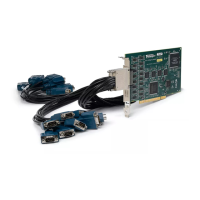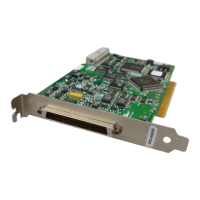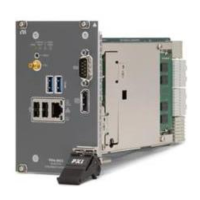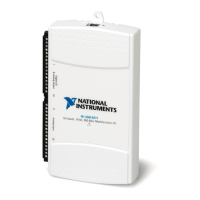
Do you have a question about the National Instruments sbRIO-9607 and is the answer not in the manual?
| Product Type | Embedded Controller |
|---|---|
| Memory | 1 GB DDR3 |
| Storage | 4 GB Flash |
| Ethernet Ports | 2 |
| USB Ports | 1 |
| Digital I/O | 32 |
| Real-Time OS | NI Linux Real-Time |
| Communication Ports | RS232, RS485, CAN |
| Power Supply | 9 V to 30 V DC |
| Analog Inputs | 8 |
| Analog Outputs | 4 |
| Operating Temperature | -40 °C to 70 °C |
Specifies physical dimensions for the sbRIO-9607, including primary and secondary sides.
Details options for orienting the sbRIO-9607 during mounting for optimal performance.
Describes mounting the sbRIO-9607 to a panel for thermal conduction or convection.
Discusses the importance of heat dissipation and planning for thermal conditions.
Provides guidance on designing an enclosure that meets the sbRIO-9607's thermal requirements.
Explains how to validate thermal performance using onboard sensors and digital measurements.
Lists additional resources for managing thermal conditions, like design examples and case studies.
Introduces the various ports and connectors available on the sbRIO-9607 device.
Describes the power connector pinout, including common and power input pins.
Details the RJ-45 Gigabit Ethernet port, its pinout, and auto-negotiation capabilities.
Explains the RS-232 serial port, its pinout, and accessories for connection.
Describes the CAN port, its pinout, and accessories for connecting to a CAN bus.
Details the USB host ports, supported devices, and retention mechanisms for connectors.
Explains the function of the RESET button for processor reset and system behavior.
Illustrates the different reset behaviors based on how the RESET button is operated.
Describes the indications provided by the POWER LED, indicating if the device is ON or OFF.
Details the various states and meanings of the STATUS LED for system diagnostics.
Explains how to define and use the USER1 and USER FPGA1 LEDs for custom application feedback.
Lists the indications for the Ethernet link status and speed LEDs.
Describes the RTC battery, its role in maintaining time when unpowered, and specifications.
Explains how the device synchronizes its system clock with the internal RTC at startup.
Shows the dimensions and locations for connecting an RMC to the NI sbRIO device.
Lists RMC connector pins with specific functions like power, ground, and system control signals.
Describes the general purpose digital I/O pins on the RMC connector and their usage.
Provides a detailed pinout of the RMC connector, mapping pin numbers to their functions.
Details voltage tolerance, maximum current, and noise specifications for RMC power rails.
Describes the electrical characteristics and I/O standards for RMC connector pins.
Explains powering the sbRIO-9607 via the RMC connector's VIN_Filtered input pins.
Details the VBAT pin on the RMC connector for powering the onboard RTC and its specifications.
Covers USB host and device modes, interface compatibility, and maximum data rates.
Discusses RMC Ethernet interface requirements, magnetics, and LED behavior for link and speed.
Explains C Series DIO support on the RMC, including power requirements and connection details.
Describes the RMC RST# pin, indicating power validity or reset status.
Details the SYS_RST# signal for resetting the sbRIO-9607 processor and FPGA.
Explains the FPGA_CONF pin, indicating when the FPGA has been programmed.
Covers configurable FPGA DIO pins on the RMC for interfaces like UART, CAN, and SDIO.
Details the circuitry, impedance, and capabilities of FPGA DIO channels on the RMC connector.
Explains SRCC and MRCC pins for clock distribution and import/export capabilities in FPGAs.
Discusses support for additional UART interfaces on the RMC, requiring external transceivers.
Covers CAN transceiver requirements, design guidelines, and specifications for the RMC.
Details SDIO support on the RMC, including design guidelines and connector recommendations.
Provides instructions for wiring the external DC power supply connector to the sbRIO-9607.
Describes the power-on sequence, including the POST and LED behavior.
Explains how to calculate the total power consumption by summing component power requirements.
Guides on connecting the sbRIO-9607 to a host computer using the RJ-45 Ethernet port.
Steps to locate the sbRIO-9607 on a network using DHCP for IP address assignment.
Steps to locate the sbRIO-9607 on a network using a static IP address configuration.
Instructions for configuring the sbRIO-9607's startup behavior using MAX software.
Lists and describes available startup options like Force Safe Mode and Enable Console Out.
Guides on selecting and configuring an FPGA application to run automatically at startup.
Explains CAN bus topology, signal pairs, and the necessity of termination resistors.
Lists ISO 11898 specifications for CAN_H and CAN_L wire characteristics.
Details the required specifications for CAN bus termination resistors (Rt).
Discusses allowable cable lengths, stub lengths, and node count for CAN networks.
Describes the file system conventions used by the sbRIO-9607, following UNIX-style conventions.












